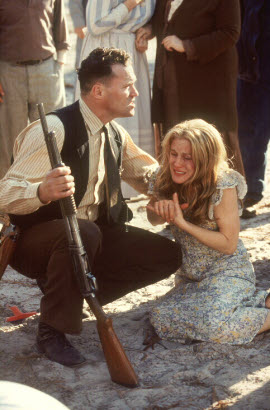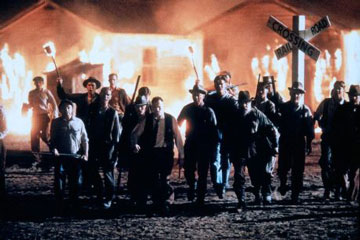ROSEWOOD and “ROSEWOOD”
The movie “Rosewood” (release date 2/21/97, director John Singleton, with Jon Voigt and Ving Rhames) is a dramatization. It doesn’t claim to be historically accurate.
- It shows Fanny Taylor being beaten by a white lover, then claiming a Black man had done it. What actually happened simply isn’t known.

- Rosewood is shown as somewhat richer, and the nearby mill-town of Sumner as poorer, than they (evidently) were.
- Ving Rhames’ character is an invention. It’s based on a contemporaneous Black reporter’s (apparently unfounded) stories, that the defense was led by an African-American veteran from his own home town, Chicago.
- Far more deaths are shown on screen than the eight which have been documented. No known eyewitness said he saw any women hung, as shown, nor has any rumored “mass grave” been found.
- The county sheriff leads the massacre mob to Rosewood. The real leader was a self-appointed vigilante named Poly Wilkerson.
Are these important? Maybe not. The movie evokes the time and place powerfully. It’s accurate in portraying Rosewood as an independent, self-reliant community with some comforts. And:
- Many lynchings resulted from alleged “rapes”, or from Black men merely looking at or accidentally bumping into White women.
- African-Americans often fought back and died heroically. They weren’t passive victims, although resistance usually triggered worse violence. At Rosewood, Sylvester Carrier was the “Man” who shot back—and probably died, although some say he escaped alive.
- Thousands died during the 50-plus years of the “Lynch-law Era”, but casualty counts are hard to verify. Boastful or traumatized witnesses often exaggerated the death counts in “race riots”.

Perhaps the movie’s greatest problem is that it reinforces some societal myths and stereotypes. The White perpetrators (with the ambiguous exceptions of John Wright and the railroad men) are dismissed as evil, weak, or “trashy”, beginning with Fanny Taylor; and the role of Rosewood’s women and children, first in saving themselves, and later in bringing the case to the public, is downplayed or ignored.
— and Rosewood Reborn
As with any mass media account, the radio documentary Rosewood Reborn has to select and simplify, but actual voices of Rosewood tell the story. Listeners hear no fewer than five survivors, plus white witnesses. They contradict each other with minimal editorializing. Rosewood Reborn recounts the survivors’ ground-breaking struggle for justice, too. And it preserves essential ambiguities:
- We simply do not know who attacked Fanny Taylor, or why: the witnesses are contradictory.
- The men who attacked Rosewood apparently considered themselves a righteous, even legally constituted posse. Yet as far as we know, lawmen took no direct part in the fate of Rosewood, to attack or defend.
- Virtually everyone in Rosewood’s story believed they were doing the right–or at least, a righteous thing, however violent. That includes not only whites who interpreted the beating of Fanny Taylor as a rape, but also the descendants, reporters, researchers, lawyers, politicians and producers (this one included) who emphasize what they think most important about the story, and (necessarily) downplay the rest. Thus “the whole truth” has never been–and probably cannot ever be told.
These are subtle points, but important. By allowing the participants to speak for themselves, we hope Rosewood Reborn draws listeners into the story, encourages them to feel themselves to be “there”, and to consider the choices they might make in similar circumstances. By showing Rosewood’s essential mysteries–the rush to judgment on false or incomplete perceptions; the “objective” reports that contributed to fear and violence; the dubious roles of ambiguous authorities—we hope to emphasize Rosewood’s relevance today.
Some have said as many as 500 were killed. But the entire population of Rosewood was only about 150 people. Survivors scattered all over the state and lost track with each other. No-one tried to trace them for 60 years, when St. Petersburg Times reporter Gary Moore started investigating. Moore ultimately concluded that even counting “indirect” deaths, probably fewer than twelve and certainly less than 20 died. He apparently spoke to more witnesses than anyone else, but his research has not been independently reviewed. We hope that Rosewood’s prominence will lead to publication of his book, perhaps online.

